This list is of the Cultural Properties of Japan designated in the category of paintings (絵画, kaiga) for the Prefecture of Tottori. [1]
National Cultural Properties
As of 1 July 2019, three Important Cultural Properties have been designated (including one * National Treasure), being of national significance. [2] [3] [4]
| Property | Date | Municipality | Ownership | Comments | Image | Dimensions | Coordinates | Ref. |
|---|---|---|---|---|---|---|---|---|
| *
Fugen Bosatsu, colour on silk 絹本著色普賢菩薩像 kenpon chakushoku Fugen Bosatsu zō |
late Heian period | Chizu | Bujō-ji ( 豊乗寺) |
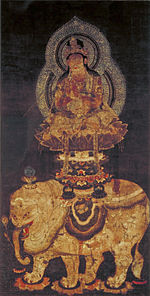 |
102.4 centimetres (40.3 in) by 52.1 centimetres (20.5 in) | 35°15′38″N 134°12′23″E / 35.260513°N 134.206388°E | [1] | |
|
Fugen and the Ten
Rakshasa, colour on silk 絹本著色普賢十羅刹女像 kenpon chakushoku Fugen jū-rasetsu-nyo zō |
Kamakura period | Tottori | Jōnin-ji (常忍寺) | with two of the Four Heavenly Kings in the foreground and two bodhisattvas behind [5] |
 |
35°30′08″N 134°13′18″E / 35.502265°N 134.221709°E | [2] | |
|
Yōryū Kannon, colour on silk 絹本著色楊柳観音像 kenpon chakushoku Yōryū Kannon zō |
Goryeo dynasty | Tottori |
Bujō-ji (
豊乗寺) (kept at Tottori Prefectural Museum) |
Goryeo Buddhist painting; alternatively identified as of Yuan origin [6] |
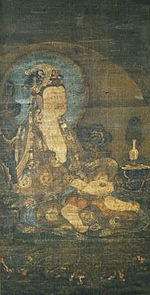 |
106 centimetres (42 in) by 54.6 centimetres (21.5 in) | 35°30′30″N 134°14′10″E / 35.508282°N 134.236139°E | [3] |
Prefectural Cultural Properties
As of 1 May 2019, twenty-six properties have been designated at a prefectural level. [7] [8]
| Property | Date | Municipality | Ownership | Comments | Image | Dimensions | Coordinates | Ref. |
|---|---|---|---|---|---|---|---|---|
| Dragon and Tiger
byōbu 龍虎図屏風 ryūko zu byōbu |
late Edo period | Tottori | private | pair of six-fold screens by Katayama Yōkoku ( 片山楊谷) |

 |
[4] | ||
|
Sanpō-Kōjin, colour on silk 絹本着色三宝荒神像 kenpon chakushoku Sanpō-Kōjin zō |
Kamakura period | Tottori | Daiankō-ji (大安興寺) (kept at Tottori Prefectural Museum) |
 |
98.4 centimetres (38.7 in) by 39.7 centimetres (15.6 in) | 35°30′30″N 134°14′10″E / 35.508282°N 134.236139°E | [5] | |
|
Aizen Myōō, colour on silk 絹本着色愛染明王像 kenpon chakushoku Aizen Myōō zō |
Kamakura period | Tottori | Daiankō-ji (大安興寺) (kept at Tottori Prefectural Museum) |
 |
98.1 centimetres (38.6 in) by 39.6 centimetres (15.6 in) | 35°30′30″N 134°14′10″E / 35.508282°N 134.236139°E | [6] | |
|
Godai Myōō, colour on silk 絹本着色五大明王像 kenpon chakushoku Godai Myōō zō |
Kamakura period | Tottori | Daiankō-ji (大安興寺) (kept at Tottori Prefectural Museum) |
five scrolls |


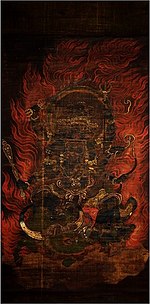

 |
144 centimetres (57 in) by 70 centimetres (28 in) (Fudō Myōō); 108 centimetres (43 in) by 54 centimetres (21 in) | 35°30′30″N 134°14′10″E / 35.508282°N 134.236139°E | [7] |
| Partition paintings from the Former
Kōkoku-ji
Shoin 旧興国寺書院障壁画 kyū-Kōkokuji shoin shōhekiga |
1796 | Tottori | Tottori Prefectural Museum | 35°30′30″N 134°14′10″E / 35.508282°N 134.236139°E | [8] | |||
|
The Tale of Heike (Vanguard at
Uji River and the Dropped Bow),
byōbu 平家物語 宇治川先陣・弓流図屏風 Heike monogatari Uji-gawa senjin・yumi-nagashi byōbu |
C19 | Tottori | Watanabe Art Museum | by Nemoto Yūga ( 根本幽峨) |

 |
35°31′14″N 134°13′39″E / 35.520658°N 134.227377°E | [9] | |
|
Ikeda Tsuneoki, by
Kanō Naonobu 池田恒興像(狩野尚信筆) Ikeda Tsuneoki zō (Kanō Naonobu hitsu) |
C17 | Tottori | Tottori Prefectural Museum |
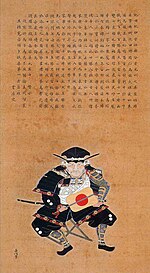 |
81 centimetres (32 in) by 37 centimetres (15 in) | 35°30′30″N 134°14′10″E / 35.508282°N 134.236139°E | [10] | |
| 500
Arhats 五百羅漢図 gohyaku rakan zu |
C18 | Kurayoshi | private | one hundred scrolls; by local artist Yoshida Hosui (吉田保水) |
 |
[11] | ||
| Bamboo and Plum, colour on paper with
gold ground - Plants and Insects, colour on paper 紙本金地著色竹梅図・紙本著色草虫図 衝立 shihon kinji chakushoku chikubai zu・shihon chakushoku sōchū zu tsuitate |
late Edo period | Tottori | Tottori Prefectural Museum | pair of screens by Oki Ichiga ( 沖一峨) | 35°30′30″N 134°14′10″E / 35.508282°N 134.236139°E | [12] | ||
|
Amida Triad, colour on silk 絹本着色阿弥陀三尊来迎図 kenpon chakushoku Amida sanzon zu |
C14 | Tottori | private |
 |
[13] | |||
| Kiku Jidō and Flowers and Birds 菊慈童・花鳥図 Kiku Jidō kachō zu |
late Edo period | Tottori | private | three scrolls by Katayama Yōkoku ( 片山楊谷) |
 |
[14] | ||
|
Tōhō Saku, colour on silk 絹本著色東方朔図 kenpon chakushoku Tōhō Saku zu |
Edo period | Tottori | Tottori Prefectural Museum | by Hijikata Tōrei ( 土方稲嶺) |
 |
99.8 centimetres (39.3 in) by 40.6 centimetres (16.0 in) | 35°30′30″N 134°14′10″E / 35.508282°N 134.236139°E | [15] |
| Tigers and Bamboo
byōbu 竹虎図屏風 chikko zu byōbu |
late Edo period | Tottori | private | pair of six-fold screens by Katayama Yōkoku ( 片山楊谷) |

 |
153.4 centimetres (60.4 in) by 358.7 centimetres (141.2 in) | [16] | |
| Journey to the East, Scenes of Cultivation, and Flowers 絹本著色東下り・耕作・草花図 kenpon chakushoku azuma-kudari kōsaku kusabana zu |
late Edo period | Tottori | Tottori Prefectural Museum | five scrolls by Oki Ichiga ( 沖一峨); Journey to the East is based on an episode in Ise Monogatari |
 |
35°30′30″N 134°14′10″E / 35.508282°N 134.236139°E | [17] | |
|
Mandala of the Two Realms, colour on silk 絹本著色不動明王像 kenpon chakushoku ryōkai mandara zu |
Kamakura period | Tottori |
Bujō-ji (
豊乗寺) (kept at Tottori Prefectural Museum) |

 |
143 centimetres (56 in) by 130 centimetres (51 in) | 35°30′30″N 134°14′10″E / 35.508282°N 134.236139°E | [18] | |
|
Fudō Myōō, colour on silk 絹本著色不動明王像 kenpon chakushoku Fudō Myōō zō |
Kamakura period | Tottori |
Bujō-ji (
豊乗寺) (kept at Tottori Prefectural Museum) |
 |
86 centimetres (34 in) by 39 centimetres (15 in) | 35°30′30″N 134°14′10″E / 35.508282°N 134.236139°E | [19] | |
| Flowers and Birds, colour on silk 絹本著色花鳥図 kenpon chakushoku kachō zu |
late Edo period | Chizu | private | two scrolls; by Shimada Gentan ( 島田元旦) |

 |
134 centimetres (53 in) by 70 centimetres (28 in) | 35°15′52″N 134°13′35″E / 35.264403°N 134.226494°E | [20] |
|
Shaka and the Sixteen Benevolent Deities, colour on silk 絹本著色釈迦十六善神像 kenpon chakushoku Shaka jūroku zenjin zō |
late Kamakura period | Tottori | Daiankō-ji (大安興寺) (kept at Tottori Prefectural Museum) |
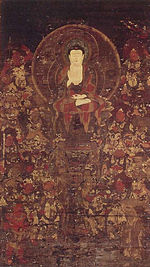 |
35°30′30″N 134°14′10″E / 35.508282°N 134.236139°E | [21] | ||
|
Saigyō Viewing
Mount Fuji, colour on silk 絹本著色富士見西行図 kenpon chakushoku Fuji-mi Saigyō zu |
late Edo period | Tottori | private (kept at Tottori Prefectural Museum) |
three scrolls, with inscriptions by Kagawa Kageki ( 香川景樹) and Kamo Suetaka (加茂季鷹); [9] by Oki Tanyō ( 沖探容) |


 |
106.7 centimetres (42.0 in) by 33.5 centimetres (13.2 in) | 35°30′30″N 134°14′10″E / 35.508282°N 134.236139°E | [22] |
| Shoal of Carp, colour on silk 絹本著色群鯉図 kenpon chakushoku gunkoi zu |
1836 | Tottori | Tottori Prefectural Museum | by Kuroda Tōkō ( 黒田稲皐) |
 |
146 centimetres (57 in) by 55.2 centimetres (21.7 in) | 35°30′30″N 134°14′10″E / 35.508282°N 134.236139°E | [23] |
| Shoal of Swimming Carp, ink on paper, six-fold byōbu 紙本墨画群鯉游泳図六曲屏風 shihon bokuga gunkoi yūei zu rokkyoku byōbu |
1824 | Tottori | Tottori Prefectural Museum | pair of screens; by Kuroda Tōkō ( 黒田稲皐) (alternatively attributed to Kuroda Inamine (黒田稲嶺)) |

 |
160 centimetres (63 in) by 375.5 centimetres (147.8 in) | 35°30′30″N 134°14′10″E / 35.508282°N 134.236139°E | [24] |
| Fierce Tigers, colour on silk 絹本著色猛虎図 kenpon chakushoku mōko zu |
late C18 | Tottori | private (kept at Tottori Prefectural Museum) |
three scrolls by Katayama Yōkoku ( 片山楊谷) |
   |
35°30′30″N 134°14′10″E / 35.508282°N 134.236139°E | [25] | |
| Dragon in Clouds, ink on paper 紙本墨画雲竜図 shihon bokuga unryū zu |
late Edo period | Tottori | Tottori Prefectural Museum | two scrolls; by Hijikata Tōrei ( 土方稲嶺) |

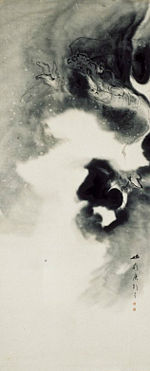 |
57.5 centimetres (22.6 in) by 134.0 centimetres (52.8 in) | 35°30′30″N 134°14′10″E / 35.508282°N 134.236139°E | [26] |
| Old Tree, light colour on paper 紙本淡彩老樹図 shihon tansai roju zu |
late Edo period | Tottori | private | by Takebe Bokusai (建部僕斎) |
 |
35°29′31″N 134°14′47″E / 35.492019°N 134.246428°E | [27] | |
|
Thirty-Six Immortals of Poetry 三十六歌仙額 shihon tansai roju zu |
1650 | Tottori |
Tottori Tōshō-gū (kept at Tottori Prefectural Museum) |
thirty-six panels by Kanō Tan'yū ( Ono no Komachi pictured) |
 |
58.7 centimetres (23.1 in) by 36.8 centimetres (14.5 in) | 35°30′30″N 134°14′10″E / 35.508282°N 134.236139°E | [28] |
| View of
Edo, colour on silk 絹本著色江戸風景図 kenpon chakushoku Edo fūkei zu |
Edo period | Tottori | private (kept at Tottori Prefectural Museum) |
|
35°30′30″N 134°14′10″E / 35.508282°N 134.236139°E | [29] |
See also
- Cultural Properties of Japan
- List of National Treasures of Japan (paintings)
- Japanese painting
- Kamiyodo Haiji
- List of Historic Sites of Japan (Tottori)
- List of Museums in Tottori Prefecture
References
- ^ "Cultural Properties for Future Generations". Agency for Cultural Affairs. Retrieved 28 August 2019.
- ^ 国宝・重要文化財 [Number of National Treasures and Important Cultural Properties by Prefecture] (in Japanese). Agency for Cultural Affairs. 1 July 2019. Retrieved 28 August 2019.
- ^ "Database of National Cultural Properties: 国宝・重要文化財(美術品)(絵画 神奈川県)" (in Japanese). Agency for Cultural Affairs. Archived from the original on 30 June 2019. Retrieved 28 August 2019.
- ^ キーワード検索 国指定 絵画 [Search: National Cultural Properties - Paintings] (in Japanese). Tottori Prefecture. Retrieved 28 August 2019.
- ^ 絹本著色 普賢十羅刹女像 [Fugen and the Ten Rakshasas] (PDF) (in Japanese). Tottori City. Retrieved 8 June 2014.
- ^ 絹本著色楊柳観音像 [Yōryū Kannon, colour on silk] (in Japanese). Tottori Prefecture. Retrieved 8 June 2014.[ permanent dead link]
- ^ キーワード検索 県指定の絵画 [Search: Prefectural Cultural Properties - Paintings] (in Japanese). Tottori Prefecture. Retrieved 25 February 2016.
- ^ 都道府県別指定等文化財件数(都道府県分) [Number of Prefectural Cultural Properties by Prefecture] (in Japanese). Agency for Cultural Affairs. 1 May 2019. Retrieved 28 August 2019.
- ^ 絹本著色富士見西行図 [Saigyō Viewing Mount Fuji] (PDF) (in Japanese). Tottori City. Retrieved 8 June 2014.
External links
- (in Japanese) Cultural Properties in Tottori Prefecture
